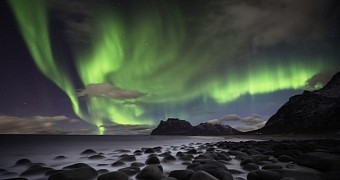Apart from the glowing, colorful beams we just can't get enough of, there is one other type of auroras forming in our planet's atmosphere, especially over polar regions.
Researchers call them black auroras and describe them as dark patches that crisscross their bright and eye-popping siblings. To inexperienced observers, they look like, well, a whole lot of nothing.
How these dark patches end up forming in the sky
The birth of black auroras is detailed in a recent paper authored by scientists with the KTH Royal Institute of Technology in Sweden and the University of Dundee in the UK, and published in the Journal of Geophysical Research: Space Physics.
The specialists explain that, as shown by previous investigations, bright and colorful auroras come into being when highly energetic electrons enter Earth's atmosphere and collide with oxygen or nitrogen atoms hovering at altitudes of 90 to 300 kilometers (56 to 186 miles).
Collisions involving nitrogen atoms produce blue or purplish-red auroras. Collisions with oxygen atoms, on the other hand, translate into auroras that are either a yellowish-green or an intense red, depending on the altitude where they happen.
The reason auroras usually form over polar regions is that our planet's magnetic field is weaker at the poles. Consequently, the highly energetic particles heading towards Earth have an easier time penetrating the atmosphere in these locations.
As for black auroras, the KTH Royal Institute of Technology team of scientists and their colleagues at the University of Dundee say that they form when electrons more or less willingly leave the planet's atmosphere and embark on an epic adventure into deep space.
“Whereas ordinary auroras are associated with downward-flowing electrons bombarding the atmosphere, the black ones are associated with electrons being sucked out from the atmospheres into space,” researcher Tomas Karlsson explained in a statement.
“This leaves deep cavities in the upper, electrically conducting-atmosphere, known as the ionosphere,” the researcher added. Interestingly, evidence indicates that black auroras are at their most impressive when the downward moving current intensifies.
Scientists aren't studying auroras just for the fun of it
The scientists behind this research project explain that, contrary to what some might assume, there are practical applications to the study of auroras over the poles and other regions across the globe. Yup, researchers aren't investigating their formation just for the fun of it.
Thus, the specialists explain that the same electron flows that create the auroras can upset power grids, GPS signals and other technological systems. Besides, there is evidence that these electron flows can influence cloud formation and, in doing so, alter Earth's climate ever so slightly.
Hence, the more they know about them, the easier it will be for researchers to mitigate the potentially negative effects that they could have on our day-to-day life.

 14 DAY TRIAL //
14 DAY TRIAL //